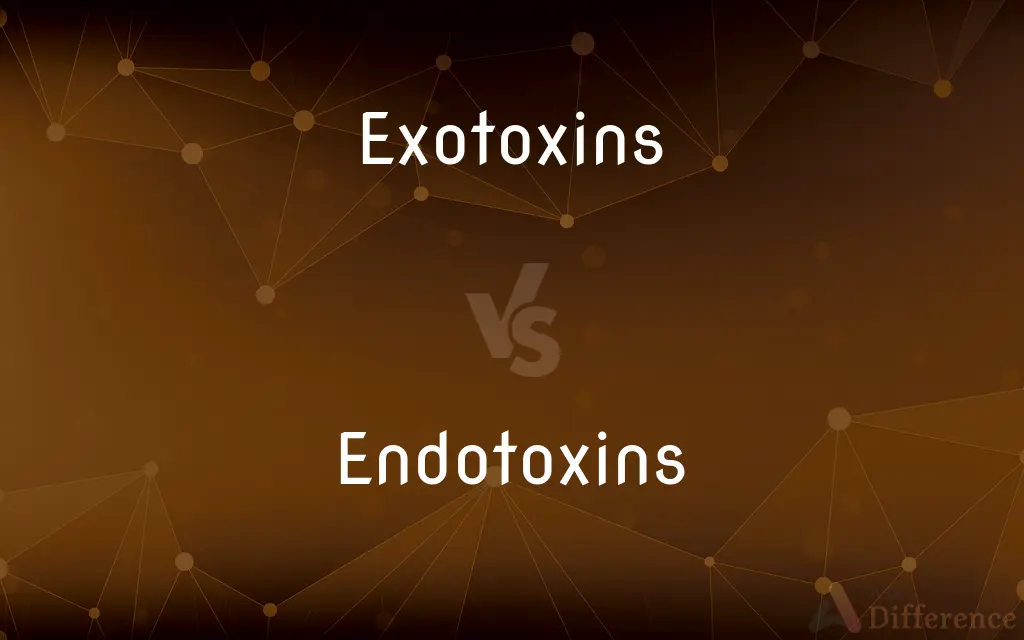Exotoxins vs. Endotoxins — What's the Difference?
Edited by Tayyaba Rehman — By Maham Liaqat — Published on September 25, 2024
Exotoxins are potent, protein-based toxins secreted by certain bacteria, causing severe effects even in small amounts. Endotoxins, are lipid components of the bacterial cell wall, are less potent but can cause significant immune responses.

Difference Between Exotoxins and Endotoxins
Table of Contents
ADVERTISEMENT
Key Differences
Exotoxins are produced by both Gram-positive and Gram-negative bacteria. These toxins are released into the surrounding environment and can target specific cellular functions, leading to diseases like tetanus and diphtheria. Endotoxins, on the other hand, are found only in the outer membrane of Gram-negative bacteria. They are not secreted but are released when the bacteria die and the cell wall breaks apart, often leading to fever and shock in severe cases.
Exotoxins exhibit high potency, and even minute quantities can cause severe illness. They are often heat labile, meaning they can be inactivated by heat. Endotoxins are considerably less potent than exotoxins but can cause serious health problems, such as septic shock, when present in high concentrations. Unlike exotoxins, they are heat stable and can withstand high temperatures.
The specificity of exotoxins is high, as they can target specific cell types or tissues, causing precise and distinct symptoms. This specificity is due to the protein nature of exotoxins, allowing them to bind to specific receptors on the host cells. Endotoxins have a broader, less specific action, primarily triggering the immune system and causing inflammation.
The immunogenicity of exotoxins is another distinguishing factor. Exotoxins can elicit a strong immune response, leading to the production of neutralizing antibodies called antitoxins. This property is exploited in vaccine development. In contrast, endotoxins induce a weaker immune response and are poor immunogens, making the development of vaccines against them more challenging.
The genetic origin of these toxins varies. Exotoxins are often encoded by plasmids or bacteriophages, allowing their genes to be transferred between bacteria. This transfer can lead to the spread of toxin-producing ability among bacterial populations. Endotoxins, being part of the bacterial cell wall, are encoded by the bacterial genome and are intrinsic to Gram-negative bacteria.
ADVERTISEMENT
Comparison Chart
Composition
Proteins
Lipopolysaccharides (LPS)
Potency
High, effective in small amounts
Lower, requires larger amounts
Heat Stability
Usually heat labile
Heat stable
Target Specificity
High, targets specific cells
Low, generally causes immune activation
Release
Secreted by live bacteria
Released from dead cells
Immunogenicity
High, induces antitoxin production
Low, poor immunogen
Associated Bacteria
Gram-positive and Gram-negative
Primarily Gram-negative
Clinical Examples
Tetanus, diphtheria
Septic shock, fever
Genetic Origin
Plasmids, bacteriophages
Bacterial genome
Compare with Definitions
Exotoxins
Often encoded by plasmids or bacteriophages.
The gene for tetanus toxin is often carried on a plasmid.
Endotoxins
Components of the outer membrane of Gram-negative bacteria.
Lipopolysaccharide (LPS) from E. coli is an endotoxin.
Exotoxins
Potent toxins secreted by bacteria, causing specific diseases.
Botulinum toxin causes botulism.
Endotoxins
Released upon bacterial cell death.
Antibiotic treatment of a Gram-negative infection can release endotoxins.
Exotoxins
Can be neutralized by specific antitoxins.
Diphtheria toxin is neutralized by the diphtheria antitoxin.
Endotoxins
Cause fever and shock when in the bloodstream.
Endotoxins can trigger septic shock in severe bacterial infections.
Exotoxins
Target specific cells or tissues.
Cholera toxin specifically targets intestinal epithelial cells.
Endotoxins
Poorly immunogenic and do not elicit strong antibody responses.
Vaccines against endotoxins are difficult to develop.
Exotoxins
Heat labile and can be inactivated by heating.
Boiling food can inactivate exotoxins produced by foodborne pathogens.
Endotoxins
Heat stable and not easily inactivated.
Endotoxins remain active even after boiling.
Exotoxins
A poisonous substance secreted by a microorganism and released into the medium in which it grows.
Endotoxins
A toxin produced by certain bacteria and released upon destruction of the bacterial cell.
Exotoxins
Plural of exotoxin
Endotoxins
Plural of endotoxin
Common Curiosities
Are endotoxins released by living bacteria?
No, endotoxins are released when Gram-negative bacteria die and their cell walls break down.
Why are exotoxins more potent than endotoxins?
Exotoxins are more potent because they are enzymes that catalyze specific biochemical reactions in the host, leading to severe symptoms even in minute quantities.
How do endotoxins cause symptoms?
Endotoxins primarily cause symptoms by triggering the body's immune response, leading to fever, inflammation, and in severe cases, shock.
How do endotoxins differ from exotoxins?
Endotoxins are lipid components of Gram-negative bacterial cell walls, released upon cell death, and generally cause fever and inflammation, contrasting with the potent, specific action of protein-based exotoxins.
Can exotoxins be inactivated by heat?
Yes, exotoxins are usually heat labile and can be inactivated by heating.
Why are endotoxins considered poor immunogens?
Endotoxins are poor immunogens because they induce a general immune response rather than a specific antibody response, making effective vaccine development challenging.
What makes endotoxins heat stable?
The lipid composition of endotoxins contributes to their heat stability, allowing them to withstand high temperatures.
What clinical conditions are associated with exotoxins?
Conditions such as tetanus, diphtheria, and botulism are associated with exotoxins.
What are exotoxins?
Exotoxins are potent, protein-based toxins secreted by bacteria, capable of causing severe diseases.
What is the role of exotoxins in bacterial infections?
Exotoxins directly harm the host by disrupting cellular functions, leading to diseases specific to the toxin-producing bacteria.
Are all bacteria capable of producing exotoxins?
No, only certain bacteria, both Gram-positive and Gram-negative, have the genetic capability to produce exotoxins.
Can you vaccinate against exotoxins?
Yes, vaccines can be developed against exotoxins by using their inactivated forms or toxoids to elicit an immune response.
How are exotoxins different from other bacterial proteins?
Exotoxins are specifically secreted by bacteria to cause disease, unlike other bacterial proteins that may serve structural or metabolic functions.
Can the presence of endotoxins in the body be beneficial?
While endotoxins can stimulate the immune system, their presence in high concentrations is generally harmful and can lead to severe health issues.
Share Your Discovery

Previous Comparison
OBD1 vs. OBD2
Next Comparison
On-road Diesel vs. Off-road DieselAuthor Spotlight
Written by
Maham LiaqatEdited by
Tayyaba RehmanTayyaba Rehman is a distinguished writer, currently serving as a primary contributor to askdifference.com. As a researcher in semantics and etymology, Tayyaba's passion for the complexity of languages and their distinctions has found a perfect home on the platform. Tayyaba delves into the intricacies of language, distinguishing between commonly confused words and phrases, thereby providing clarity for readers worldwide.













































